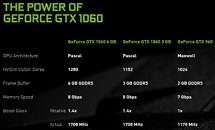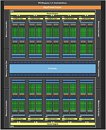Raevenlord
News Editor
- Joined
- Aug 12, 2016
- Messages
- 3,755 (1.23/day)
- Location
- Portugal
| System Name | The Ryzening |
|---|---|
| Processor | AMD Ryzen 9 5900X |
| Motherboard | MSI X570 MAG TOMAHAWK |
| Cooling | Lian Li Galahad 360mm AIO |
| Memory | 32 GB G.Skill Trident Z F4-3733 (4x 8 GB) |
| Video Card(s) | Gigabyte RTX 3070 Ti |
| Storage | Boot: Transcend MTE220S 2TB, Kintson A2000 1TB, Seagate Firewolf Pro 14 TB |
| Display(s) | Acer Nitro VG270UP (1440p 144 Hz IPS) |
| Case | Lian Li O11DX Dynamic White |
| Audio Device(s) | iFi Audio Zen DAC |
| Power Supply | Seasonic Focus+ 750 W |
| Mouse | Cooler Master Masterkeys Lite L |
| Keyboard | Cooler Master Masterkeys Lite L |
| Software | Windows 10 x64 |
Due to the usual metrics and happenstances with foundry yields and wafer production, some chips contained in the production wafers are defective, with inoperative sections. This is always taken into account by companies, such as NVIDIA, while designing their product stacks (with the GTX 1070/1080 sharing the same silicon, and GTX 1070 samples being, mostly, defective versions of the fully-enabled Pascal GP104-140 chip). Other times, when supply of defective chips that can guarantee sufficient numbers of lower-tiered products, such as the GTX 1070, is insufficient to guarantee market demands (basically, things go better than expected at production), some sections of fully-operational chips are deactivated, so that it has the same working resources as the (otherwise defective) chips. Sometimes, like it happened with the Radeon HD 6950, these chips' resources can even be unlocked by simple BIOS flashing. According to recent reports, NVIDIA is bound to do something akin to that, by reusing GP104-140 chips on their GTX 1060 3 GB variants.


It appears as if NVIDIA is dealing with the latter case, in that the defective GP104-140 silicon appears to have more defects than the allowed for the chips to even achieve GTX 1070 specifications. The problem with this is that NVIDIA seems to think they don't have any more space in their product stack between the GTX 1060 6 GB and the GTX 1070. As such, the company is reportedly moving towards "cannibalizing" some of these defective GP104-140 chips towards the GTX 1060 3 GB models, effectively deactivating (through fusing or BIOS locks) the CUDA Cores in excess of 1152 (the number of cores in the GTX 1060 3GB).
Looking at the CUDA core counts, this move may seem puzzling - the fully-enabled GP 104 chip counts with 2,560 CUDA cores, while the GTX 1070 variants have only 1,920 of these being operational. This means that the defective chips count with even less operational CUDA cores than the 1,920 present in the GTX 1070. Naturally, one would assume that these chips would be repurposed as GTX 1060 6 GB, with 1,280 operational CUDA cores, instead of the 1,152 found on the 3 GB version of the card. What this may mean is that yields on the GP106 chip are good, with few defective cores, and that NVIDIA is looking to use these GP 104 chips as additions of sorts to the lacking numbers of GP106 defective chips, filling a more immediate gap in supply for the 1,152 CUDA core-version of the chip.
These cards may have higher power requirements than normal GP106-based GTX 1060's, which is why NVIDIA is supposedly playing this one quiet - reportedy, the GTX 1060 re-purposed GP104 chips can be exclusive to the chinese market, or even OEM-only cards. Most of this information's credibility is based on a few lines included in NVIDIA's latest driver, revealing the ID of this card (1B8_ family means GP104): NVIDIA_DEV.1B84 = "NVIDIA GeForce GTX 1060 3GB".
View at TechPowerUp Main Site


It appears as if NVIDIA is dealing with the latter case, in that the defective GP104-140 silicon appears to have more defects than the allowed for the chips to even achieve GTX 1070 specifications. The problem with this is that NVIDIA seems to think they don't have any more space in their product stack between the GTX 1060 6 GB and the GTX 1070. As such, the company is reportedly moving towards "cannibalizing" some of these defective GP104-140 chips towards the GTX 1060 3 GB models, effectively deactivating (through fusing or BIOS locks) the CUDA Cores in excess of 1152 (the number of cores in the GTX 1060 3GB).
Looking at the CUDA core counts, this move may seem puzzling - the fully-enabled GP 104 chip counts with 2,560 CUDA cores, while the GTX 1070 variants have only 1,920 of these being operational. This means that the defective chips count with even less operational CUDA cores than the 1,920 present in the GTX 1070. Naturally, one would assume that these chips would be repurposed as GTX 1060 6 GB, with 1,280 operational CUDA cores, instead of the 1,152 found on the 3 GB version of the card. What this may mean is that yields on the GP106 chip are good, with few defective cores, and that NVIDIA is looking to use these GP 104 chips as additions of sorts to the lacking numbers of GP106 defective chips, filling a more immediate gap in supply for the 1,152 CUDA core-version of the chip.
These cards may have higher power requirements than normal GP106-based GTX 1060's, which is why NVIDIA is supposedly playing this one quiet - reportedy, the GTX 1060 re-purposed GP104 chips can be exclusive to the chinese market, or even OEM-only cards. Most of this information's credibility is based on a few lines included in NVIDIA's latest driver, revealing the ID of this card (1B8_ family means GP104): NVIDIA_DEV.1B84 = "NVIDIA GeForce GTX 1060 3GB".
View at TechPowerUp Main Site
Last edited:






